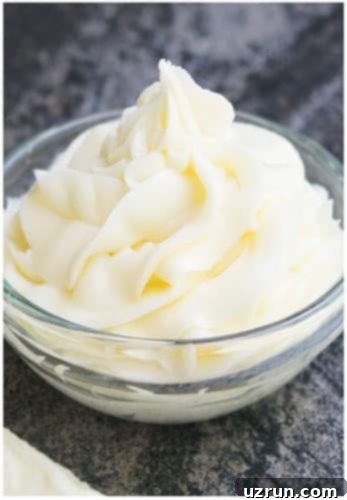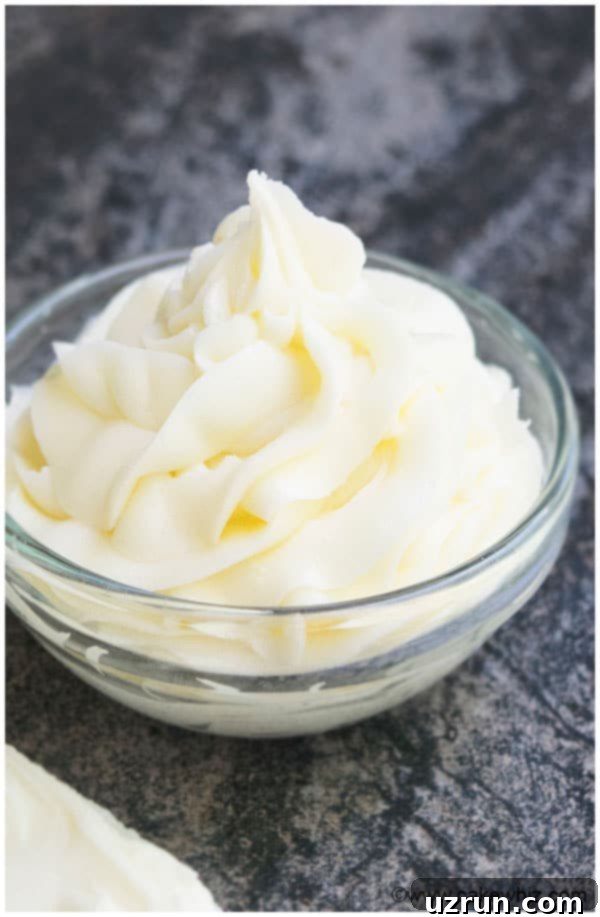The Ultimate Guide to Cooked Flour Buttercream (Ermine Frosting): Stable, Velvety, and Perfect for Piping
Discover the secret to a truly exceptional frosting with this tried-and-true cooked flour buttercream, widely known as Ermine frosting. This quick and easy recipe yields a buttercream that is incredibly stable, remarkably smooth, and delightfully creamy, making it an absolute dream for piping intricate designs and flawlessly decorating cakes and cupcakes. If you’ve been searching for a light, airy frosting that holds its shape beautifully and melts in your mouth without being overly sweet, your quest ends here.
This cherished recipe hails from a very old family cookbook, a testament to its timeless appeal and enduring quality. It has graced many of my favorite desserts, including rich chocolate cake, moist red velvet cake, and even a vibrant mango cherry cake, always delivering a consistently amazing taste and texture. Its unique composition sets it apart from traditional frostings, offering a soft, creamy, and wonderfully fluffy consistency that feels remarkably light on the palate. Many find it preferable to classic American buttercream due to its distinct, elegant finish.
What is Ermine Frosting? A Beloved Classic Reimagined
Ermine frosting, also affectionately called cooked flour buttercream, is a classic, old-fashioned frosting that stands out in the world of sweets. Unlike many buttercreams that rely heavily on powdered sugar for structure, Ermine frosting uses a cooked roux made from milk, flour, and sugar as its base. This “flour pudding,” as it’s sometimes called, is then whipped into butter (and sometimes shortening) to create a light, fluffy, and incredibly stable frosting. Its texture is often compared to whipped cream, but with a richer flavor profile and a much greater ability to hold its form.
Historically, Ermine frosting was the go-to choice for many beloved desserts, particularly the iconic red velvet cake, before cream cheese frosting rose to prominence. Its enduring popularity is no surprise, given its ability to deliver a truly luxurious mouthfeel. The addition of flour is the key to its characteristic velvety smooth texture, transforming what might seem like an unconventional ingredient into the secret weapon for a superior frosting.
Don’t be deterred by the thought of tasting flour in your frosting – you absolutely won’t! When properly cooked, the flour acts as a thickener and stabilizer, much like in a béchamel sauce, but without imparting any raw or starchy flavor. Instead, it creates an unbelievably silky and airy frosting that is far less sweet than its American counterparts, allowing other flavors to shine through.
Ermine frosting goes by many names, reflecting its rich history and diverse regional interpretations:
- Cooked frosting
- Boiled milk frosting
- Boiled icing
- Cloud frosting
- Flour frosting
- Cooked roux frosting
- Heritage frosting
- Mock buttercream icing
Why Choose Cooked Flour Buttercream? Stability, Smoothness, and Versatility
Beyond its delightful taste, Ermine frosting offers several key advantages that make it a favorite among bakers:
- Exceptional Stability: Unlike some other frostings that can be prone to melting or wilting, Ermine frosting is incredibly stable. This makes it ideal for decorating cakes and cupcakes, especially in warmer climates or when you need your creations to hold up for an extended period.
- Velvety Smooth Texture: The cooked flour base creates a uniquely smooth and creamy texture that is free of the graininess sometimes found in powdered sugar-heavy buttercreams. It pipes beautifully and spreads like a dream, leaving a flawless finish on your baked goods.
- Less Sweet: For those who find traditional American buttercream too sweet, Ermine frosting is a revelation. Its balanced sweetness allows the flavors of your cake or other fillings to truly stand out.
- Perfect for Piping: Its stability and smooth consistency make it an excellent choice for intricate piping work, from delicate borders to elaborate floral designs. It holds its shape well, ensuring your decorations look sharp and professional.
- Versatile Application: While it’s a classic pairing for red velvet cake, Ermine frosting is incredibly versatile. It complements a wide array of cakes, cupcakes, brownies, and can even be used as a luscious filling for various desserts, adding a touch of elegance to any sweet treat.
Ermine Frosting FAQs: Your Questions Answered
Let’s address some common questions about this wonderful frosting:
Does Ermine frosting need to be refrigerated?
Yes, it absolutely needs to be refrigerated. Since this frosting contains milk, which is a dairy product, it can spoil if left at room temperature for too long. Refrigeration helps preserve its freshness and prevents bacterial growth, ensuring it remains safe and delicious to eat.
How to store Ermine frosting?
To keep your Ermine frosting fresh, transfer it to an airtight container and store it in the refrigerator. It will stay fresh and delicious for up to 1 week. When you’re ready to use it again, simply let it come to room temperature and then re-whip it for a few minutes until it regains its light and fluffy consistency.
How do you make vanilla frosting without powdered sugar?
Ermine frosting is the perfect answer! Traditionally, this recipe contains no powdered sugar, relying instead on granulated sugar in the cooked flour base. While some modern variations (like mine, optionally) include a bit of powdered sugar for added sweetness or thickness, its authentic form is a fantastic option for a powdered sugar-free vanilla frosting. This highlights its unique ability to achieve a beautiful texture and flavor without the need for large quantities of confectioners’ sugar.
What is Ermine frosting used for?
The applications for Ermine frosting are vast! It’s an excellent choice for frosting cakes and cupcakes, providing a smooth canvas for decorations or a fluffy crown for your treats. It also works wonderfully on brownies and can be used as a delightful filling for various desserts, such as sandwich cookies, éclairs, or even crepes. Its stable nature means it can handle more intricate designs than many other frostings.
How to Make Ermine Frosting: A Simple Step-by-Step Guide
Making Ermine frosting is a straightforward process, though it takes a little longer than a quick American buttercream. The results, however, are absolutely worth the extra effort! Here’s a breakdown of how to achieve this delicious boiled icing:
- Prepare the Roux (Flour Pudding): Begin by combining milk, granulated sugar, and all-purpose flour in a non-stick saucepan. Cook this mixture over medium heat, whisking constantly, until it thickens into a consistency resembling a thick pudding. Constant whisking is crucial here to prevent lumps from forming.
- Cool the Roux: Once thickened, immediately remove the “flour pudding” (also known as a roux) from the heat and transfer it to a clean bowl. Cover the surface directly with plastic wrap (saran wrap) to prevent a “skin” from forming as it cools. Place the bowl in the refrigerator and allow it to cool completely. This step is vital; the roux must be thoroughly chilled and pudding-like before proceeding.
- Cream the Fats: In a separate large mixing bowl, cream together softened butter and shortening (if using, as I often do for extra stability). Beat them until they are light, fluffy, and pale in color.
- Combine and Whip: Gradually add the cooled flour mixture to the creamed butter and shortening, along with vanilla extract. Continue to mix everything together on medium-high speed until the frosting becomes incredibly light, fluffy, and smooth. This whipping process incorporates air and transforms the mixture into the signature Ermine frosting texture.
- Adjust Sweetness (Optional): If you prefer a sweeter frosting or desire a slightly thicker consistency, you can gradually beat in 1-2 cups of powdered sugar, a quarter cup at a time, until you achieve your desired taste and texture. This is an optional step, as traditionally Ermine frosting has no powdered sugar.
Once your Ermine frosting is ready, it’s perfect for piping onto cakes and cupcakes, or spreading generously on your favorite baked goods. Enjoy the smooth, light, and delicious results!
Essential Tips for Crafting Perfect Ermine Frosting
Achieving flawless Ermine frosting is all about attention to detail. Here are some invaluable tips to ensure your buttercream turns out perfectly every time:
- Use Clear Vanilla Extract: For a truly pure white frosting, opt for clear vanilla extract. Regular vanilla extract can impart a slight yellowish or brownish tint, which might alter the desired color of your frosting.
- Eliminate Lumps in the Roux: Lumps in your cooked flour mixture will lead to lumpy frosting, which is undesirable for a smooth finish. To prevent this, whisk the mixture constantly while cooking. If lumps still form, don’t despair! You can easily fix it by either running the cooled “roux mixture” through a fine mesh sieve or using a hand-held immersion blender directly in the bowl to achieve a perfectly smooth consistency before adding it to the butter.
- Constant Whisking During Cooking: As mentioned, constant whisking while cooking the milk, flour, and sugar mixture is paramount. This prevents scorching at the bottom of the pan and ensures a smooth, lump-free roux.
- For Vegan Ermine Frosting: To make this recipe suitable for a vegan diet, simply replace the whole milk with your favorite vegan milk alternative, such as soy milk, coconut milk, or almond milk. Additionally, substitute butter entirely with vegetable shortening. The result will be a surprisingly similar texture and delicious flavor.
- Achieving Pure White or Vibrant Colors: Ermine frosting is naturally an “off-white” or slightly creamy color. If you desire a brilliant pure white frosting, a small amount of white gel food coloring will do the trick. For vibrant colors like red, I’ve found that Americolor’s red gel color yields a deeper and more intense shade compared to Wilton’s red gel color, providing superior results. Always use gel food coloring, as liquid food coloring can thin out the frosting’s consistency.
- Chill Before Piping: If you find your frosting a bit too soft for intricate piping work, refrigerating it for about 30 minutes can significantly improve its stability and make it much easier to pipe with precision.
- Butter and Shortening Blend: While traditionally Ermine frosting is made with all butter, I prefer to use a combination of shortening and butter. This blend enhances the frosting’s stability, especially in warmer conditions, while still retaining the rich flavor of butter. Experiment to find your preferred ratio!
- Optional Powdered Sugar: Although classic Ermine frosting does not contain powdered sugar, I sometimes add a small amount (1-2 cups) to enhance the sweetness slightly and achieve a thicker, more robust consistency. This is entirely optional and depends on your personal preference for sweetness and texture.
- Adjusting Consistency:
- If the frosting is too thin: First, try chilling it in the refrigerator for 30-40 minutes. If it’s still too thin after chilling and re-whipping, mix in a little powdered sugar (a quarter cup at a time) to thicken it.
- If the frosting is too thick: Add a small amount of milk (a teaspoon at a time) and whip until it reaches your desired, spreadable consistency.
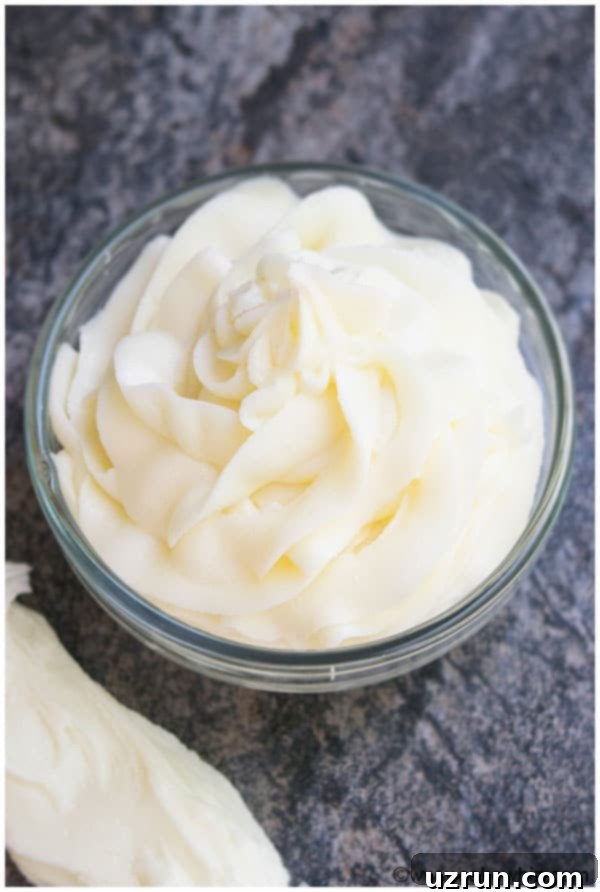
Exciting Flavor Variations for Your Cooked Flour Buttercream
One of the joys of Ermine frosting is its adaptability. Once you’ve mastered the basic recipe, you can easily transform it with various flavor additions:
- Peppermint Icing: For a refreshing twist, replace the vanilla extract with 1 teaspoon of peppermint extract. This is perfect for holiday treats or chocolate desserts.
- Rose Icing: Achieve an elegant and fragrant frosting by substituting the vanilla extract with 1 tablespoon of rose water. You can add a little more if you desire a stronger floral flavor and aroma. This pairs beautifully with light, delicate cakes.
- Coconut Icing: For a tropical escape, omit all other extracts and add 1 tablespoon of coconut extract. If you love a bit of texture, mix in about ⅓ cup of finely shredded coconut. You might need to add a touch more milk to maintain a smooth consistency after adding the shredded coconut.
- Chocolate Ermine Frosting: Transform your frosting into a decadent chocolate delight by adding ¼ cup of unsweetened cocoa powder to the recipe. Sift the cocoa powder with the flour before cooking to ensure a lump-free chocolate roux.
A note of caution: while experimenting with flavors can be fun, I’ve personally tried making Ermine frosting with cream cheese and found the combination to be quite unusual and not something I would recommend. Stick to the classic flavor profile or the suggested variations for the best results.
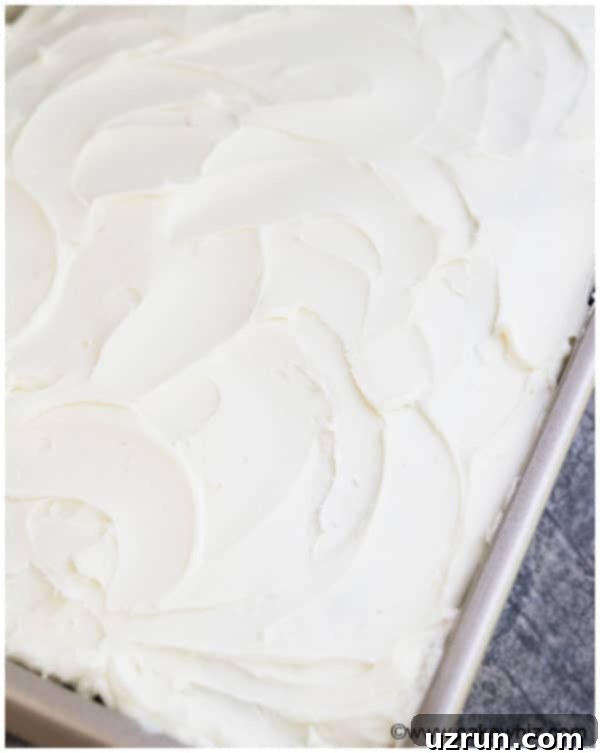
With this comprehensive guide, you’re now equipped to create the most stable, smooth, and delicious cooked flour buttercream. This Ermine frosting recipe is a true game-changer for anyone looking to elevate their baking. It’s a testament to classic baking techniques, offering a unique texture and balanced sweetness that is sure to impress.
Well, that’s all for today. Happy baking!
If you liked this cooked flour buttercream icing, you may like some of these other frosting/icing recipes too:
Royal Icing (Dries hard- Perfect for cookie decorating)
Recipe
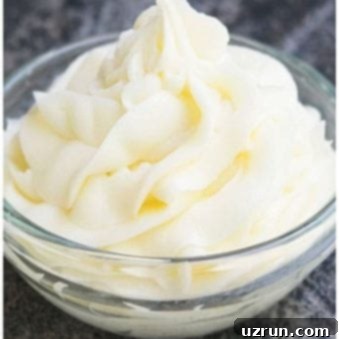
Cooked Flour Buttercream (Ermine Frosting)
Abeer Rizvi
Pin Recipe
Want to Save This Recipe?
Enter your email & I’ll send it to your inbox. Plus, get great new recipes from me every week!
By submitting this form, you consent to receive emails from CakeWhiz
Ingredients
- 1 cup Milk Whole
- 5 tablespoon All-purpose flour
- 1 cup Granulated sugar
- ½ cup Butter Unsalted
- ½ cup Shortening
- 1 tablespoon Vanilla extract Clear
- 1-2 cups Powdered sugar Optional
Instructions
-
In a non-stick saucepan, add milk, flour, granulated sugar and cook on medium heat, while constantly whisking everything together.
-
When the flour mixture starts to thicken, remove from heat and pour it into a bowl.
-
Cover the bowl with saran wrap quickly, making sure it’s directly touching the surface to prevent any “skin” formation.
-
Place this bowl in the fridge and let it cool down completely until it has the consistency of a pudding.
-
In a mixing bowl, cream together butter and shortening.
-
Add the flour mixture and vanilla extract, while constantly mixing.
-
Add powdered sugar (¼ cup at a time) and continue mixing, until you have the desired consistency and flavor. This step is optional
-
Use this frosting to pipe your cakes/cupcakes and enjoy!
Notes
- Read all my tips above.
- Leftover frosting can be stored in a sealed container in the fridge for up to 7 days.
Nutrition
An automated tool is used to calculate the nutritional information. As such, I cannot guarantee the accuracy of the nutritional information provided for any recipe on this site.
Until next time, tata my lovelies!
